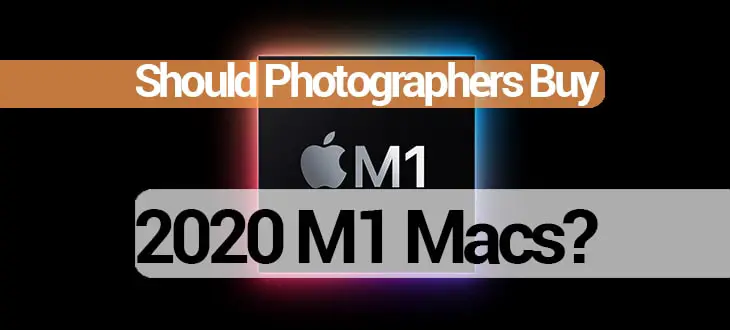With more anticipation that almost any Apple update I can remember, we now have new Mac Mini, MacBook Air, and 13″ MacBook Pro computers with M1 processors. The media is mostly gushing over the new machines raving about how much faster they are than their Intel-based predecessors. Should photographers jump on that bandwagon?
No, photographers should not buy a Mac Mini, MacBook Air, or 13″ MacBook Pro with the new M1 processors in 2020. At least not if this is going to be the primary computer for photo editing. Here is why.
M1 Macs Have a High Ceiling
I want to be clear as I go into my reasoning why photographers should not invest in an M1-based Mac computer here in late 2020 that my answer is not because I think Apples new computers are bad or will fail. Quite the opposite. I think this has massive potential to disrupt the computer industry and put considerable distance between their computers and all of the competition.
I said as much in my What Does Apple Silicon Mean For Photographers podcast episode back in July 2020. I expected these new computers to have something close to twice the performance and twice the battery life in their laptops to make them extremely compelling.
All the rave reviews seem to indicate I am justified with the expectations I set back then, especially because Apple is just getting started with their transition to Apple Silicon and we don’t have enough native applications to really know just how good the performance is.
I can’t wait to get an Apple Silicon computer and run it through my testing that is more specific to photographers. I hope to do that soon so that I can share my hands-on experience compared with better than 8 years experience heavily using Lightroom and Photoshop on Intel Macs and PCs.
I think the ceiling is extremely high for Apple Silicon Macs, they just aren’t ready for photographers to jump in quite yet.
M1 Macs – Potential of Apple Software Issues
Apple has struggled some with updates to their macOS operating system in 2019 and 2020. macOS Catalina was released back in October 2019 and had enough issues coming out of the gate I couldn’t recommend it as an upgrade for photographers until the 5th patch some 8 months later in May 2020.
Even then I could only give Catalina the “Caution” status, which means it is likely to work for most photographers but if they couldn’t afford any speed bumps they may want to wait. That “Caution” status remains today with macOS Catalina. There continue to be challenges with many peripherals (especially external hard drives) and software that hasn’t been updated to fully support Catalina.
Before you write me that comment/email/tweet to tell me you upgraded immediately and had zero issues with Catalina, I am not saying EVERY photographer had massive issues. This isn’t me guaranteeing photographers will have show stopper type issues. There is just more possibility of that kind of thing happening and it tends to happen when photographers REALLY need to get a shoot done.
With my Software Updates Status page I am trying to provide advice to working photographers who don’t have the time to have problems with their computer. There are plenty of photographers who apply updates and don’t have issues. I hear from so many who have done that for years only to end up in a terrible situation where they can’t get their client shoot delivered due to an update that went badly.
Apple released macOS Big Sur in November of 2020. One of the things I have learned over and over with my recommendation for software updates is that I can’t consider recommending a major release for at LEAST two weeks. As I write this article macOS Big Sur is simply too new to really know if it is something I can recommend for photographers who can’t afford any speed bumps with their computer.


Even worse, Adobe has only tested and claimed support on Big Sur for their Lightroom and Photoshop products with their most current release of both products. These releases from October 2020 are some of the buggiest releases I have ever seen.
I strongly discourage photographers who can’t risk having issues from using Lightroom v10 or Photoshop v22. Unfortunately those are the only versions actually supported by Adobe for macOS Big Sur running on Intel processors, let alone the new Macs with M1 processors (see below).
The risk of significant macOS issues causing problems for photographers is higher than normal running on the new Macs released in November 2020. These changes are more significant than any updates from Apple for better than a decade. Not only do we need at least two weeks to see how Big Sur goes, when you add the issues that remained with Catalina and a new processor architecture I think most photographers should sit tight and wait.
M1 Macs – Adobe Products Not Ready
I fully expect Apple to very quickly work out issues with their own software. In this context, given the size of what Apple is doing here, quickly here means by mid-2021 or so. At that point I expect things to be humming pretty smoothly with M1 Macs running Big Sur and software built to run on M1.
I cannot say the same for Adobe products most photographers are using. Adobe has not yet released Lightroom Classic or Photoshop that runs natively on the Apple Silicon M1. Adobe has released a beta for Photoshop natively compiled for M1 with pretty limited functionality and some known issues. Adobe has also promised a release of a native version of Lightroom Desktop (the new version that only offers cloud storage and works more like mobile – NOT Lightroom Classic) in 2020.

This means Lightroom Classic and Photoshop have to run under Rosetta 2, an emulator that translates the code from x86 to M1. Performance won’t be as good as applications that are built to run natively on the M1 processors, but more importantly Adobe doesn’t really offer support running Lightroom Classic or Photoshop this way.


All of this was completely expected and I have seen early reports of some photographers saying it works remarkably well, but the best we have right now is that the most current version of Lightroom Classic and Photoshop have no known issues running under Rosetta 2. The most current versions that have been riddled with bugs on Intel Macs. I hope it is obvious that isn’t great for photographers who rely on this software to deliver for clients.
What About Photographers Who Don’t Use Adobe Products?
I focus on the details of the Adobe products both because I am most familiar with them and because the majority of my readers and listeners are Adobe customers. What about those photographers who do not use Adobe products? Does an M1 Mac make more sense for them?
I don’t think so. Not here in 2020. Very little is natively built to run on the M1 processor and most software companies struggle to get things updated with macOS releases. Catalina showed us just how much they struggle. We still have a lot of software that is not fully supported on Catalina a year after the release.
There are some that are more agile and quicker to get things ready for sure. PixelMater Pro for example. They have a full updated release that pretty well came out in conjunction with the M1 Macs that is natively built for the M1 processor.
Photographers should search to see if the software they use is support on both Big Sur and M1. Here are a few of the common ones I hear about and what I could find on them:
- ON1 hasn’t been able to test their software on M1.
- Skylum software isn’t quite ready
- Couldn’t find anything official from Capture One.
- Topaz Labs has said that it is going to be several months.
Should Photographers Buy an Intel Mac When M1 Is Available?
The lack of Adobe support for the M1 is where my biggest hesitation comes with photographers buying and M1 Mac here in late 2020. I just can’t recommend any photographer who needs this to work reliably go this route right now. I fully expect things to be much better in the first quarter or so of 2021.
In fact, I think that sometime in 2021 things are going to be so buttery smooth and fast on an M1 Mac that Apple is going to put a lot of distance between them and all of their competitors. I think this is going to be super solid and that Apple is only getting started.
What is a photographer who desperately needs a new Mac this holiday season do? If you are a professional photographer who relies on your computer to pay your bills, buy an Intel-based 16″ MacBook Pro or a 27″ iMac. Check out my iMac and MacBook Pro buying guides for help in choosing the options that matter for photographers.
If you are a photographer who can handle some disruption to your workflow due to software issues or have a decent computer you can switch to if you encounter issues, I still think an Intel Mac is the way to go right now if you truly need a new computer late in 2020. These M1 Macs Apple has released are the lower end of the line-up and I expect iMac and 16″ MacBook Pro M1 updates before mid-2021. Would you kick yourself for getting in now if that happens?
Here late in 2020 the M1 Macs are for the photographers who like to be on the cutting edge of things, are technical enough to understand and deal with issues they encounter, and willing to buy another computer in the next 12 months when Apple releases the next part of their computer lineup. If that is you, then go for it, and let me know how it goes. I hope I can find a way to get a Mac Mini to do some good testing myself.

